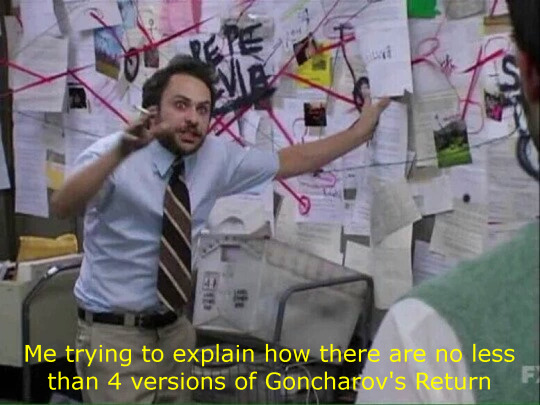#Goncharov's Return TV edit
Explore tagged Tumblr posts
Text
Goncharov's Return/Revenge discourse is like

#I've only seen a bootleg rip of Goncharov's Return (1983) dir. Alan Smithee.#but there is also#Goncharov's Revenge#Goncharov's Revenge (1983) dir Robert Zemeckis#Goncharov's Return (1983) dir Alan Smithee#Goncharov's Return TV edit#GR/R#Goncharov's Return#Alan Smithee#robert zemeckis#Goncharov#unreality#unreality cinema
92 notes
·
View notes
Text
Some tag reactions to the ongoing Goncharov DVD Saga!
But first, an update. According to my friend, no one has picked it up yet. Which is sad. But I'm placing my hopes in the guy who comes in once a week and picks up like 20 random movies. He'll hit it eventually!
I'll check on it myself when I go in to return my book.
And now, tags, under a readmore! Because there are a lot of them. If this thing passes the Color of Bees post in like 3 weeks, I'm going to lose my mind. XDDD
First, we have enthusiastic librarians, distressed librarians, and people with Opinions about our DVD shelving. XDDD

Unfortunately, even if I'd wanted to go that far, all cataloging is done at Headquarters(TM). Might have been able to wrangle a barcode if I'd planned better, but no actual catalog entry.
I'm very distressed by the idea of not alphabetizing past the first letter. However, I am intrigued by the idea of separating the movies and TV shows. But god, we can barely get them to separate the manga and graphic novels, and can't get them to catalog the manga in a way that makes sense, so that's asking too much.
And if someone decides to steal it, more power to them. XD
Next, things people want in the case!

Obviously the overwhelming response was a rickroll. XD But also the Bee Movie, the Sonic Movie, Morbius, and several things that would be really cool, if I had any kind of video editing skills at all.
Shoutout to the two people who said "empty" and "post-it note" for being correct.
Other good tags!

I cannot for the life of me think of what kind of ethical issue this would be, but that one made me laugh, because a running joke (and source of frustration) while I worked there was the idea of committing Ethics Violations.
I doubt anyone would deny me a good reference for a joke. My bosses liked me. And no harm done, after all. It's not like I took a joyride through the building in the rolling mail bin like I wanted to during curbside. :P
And lastly, whatever is going on here:

This could have been the love story of our age, but that other person missed out. Tragic.
19 notes
·
View notes
Text
The Tragic Saga of the Goncharov Tie-In Game (1995)
so since everyone has discovered goncharov i get to talk about a personal fascination of mine, which is the wild n wacky tale of the goncharov video game tie in. If youre thinking "what the hell are you talking about, there wasn't a video game tie in" theres a reason for that, bear with me
so the game came out sometime around 1995 (different sources place it at various points between 1994 and 1995), and it was one of the first properties to be licenced by sony for a console. It was originally planned to be a SNES-CD release until that console was cancelled, at which point it was ported to the playstation. if youre wondering why goncharov got a tie in like twenty years after the film released, that's kind of why it's so unheard of. sony was testing the waters with its new hardware to see if there was an older audience for gaming, and a few investors were willing to put some money behind the idea. it was actually pretty well-funded all things considered, with a budget of around $1.1m, and the gameplay was similar to that of goldeneye, which released a couple of years later. it was also fairly sophisticated, featuring branching decision trees and several different endings (I think 4? there isn't a lot of gameplay footage available, but there were at least 4)
unfortunately, development was plagued with problems from the get go. Despite its healthy budget, the studio couldn't convince any of the original cast to return to do voice work. Of course they couldn't, the film was two decades old -- you think harvey keitel was gonna bail on pulp fiction to appear in some experimental video game? of course not. so the dev team went for the next best thing: soundalikes.
the problem is, the soundalike VAs they hired weren't used to doing longform work. don't get me wrong, they did their darndest, but their experience was very much rooted in things like radio commercials and short voiceovers. they hadn't really had to act before. oh, and all but one of them hadn't seen the movie. the anecdote goes that they showed up on day one expecting a couple of days work tops, and much to their shock were handed several dozen pages of script (remember the decision trees? branching dialogue baby) and told they were employed for the next six months. Good for them, I think?
The voice acting really suffered from this. a lot of it feels very stilted, it ruins the immersion. yknow how in elder scrolls oblivion all the voice lines were recorded in alphabetical order? It sounds similar to that (altho personally i think the goncharov voice acting is a bit better lol). the directors and actors really struggled to pull everything together.
the result was that, while the game itself definitely wasn't bad, it was outright innovative in places, critics really couldn't get past the baffling performances, which they near-unanimously agreed made the game a slog. someone suggested the game should be played on mute with goncharov the film playing on a second tv, though went on to say that you wouldn't even finish the game then, because you'd just end up watching the far superior goncharov film instead. The game flopped, causing its global release to be cancelled, and was only ever distributed in the UK, Australia, and Japan.
the game had a brief stint as a cult classic, garnering a small online fandom in the early days on the internet. there is allegedly an italian fan translation out there somewhere, although a copy has never surfaced and it is considered lost media. a couple of people have come forward claiming to have worked on it -- they also claim to have met in the neopets forums of all places. i believe them -- and there are a couple of youtube videos showcasing what appears to be an italian fandub, but without the game files it's not possible to know whether theyre real or edited in post.
so now you know the story of goncharov the movie the game, my favourite game i've never played and probably never will. while it may well have been a missed opportunity, i like to think it paved the way for such classics as enter the matrix, and ratatouille the movie the game, and what would the world be like without them?
22 notes
·
View notes
Text
I’ve been seeing a lot of misinformation about Goncharov lately, and I wanted to set the record straight about this fascinating piece of Italian/American cinema history. When I first heard about it, I had a hard time believing Scorsese managed to mount this ambitious epic in the same year as his breakthrough with Mean Streets, and the truth is, he did and he didn’t…
So let’s go back to 1972. After a number of acclaimed shorts, a promising feature debut with Who’s That Knocking at My Door?, and some high-profile editing gigs, Scorsese went the way of so many young directors and helmed a low-budget feature, Boxcar Bertha, for Roger Corman’s American International Pictures. Famously, upon screening the film for his friend and proudly independent filmmaker John Cassavetes, Scorsese had a rude awakening when Cassavetes told him, “Marty, you’ve just spent a year of your life making a piece of shit.” Here the seeds of Goncharov were planted.
Hearing these words in the wake of his fellow film brat Francis Ford Coppola’s masterful work on The Godfather, Scorsese knew his next work would be need to be a simultaneously grand and personal vision. He found the inspiration for his intercontinental saga in the Goncharov trilogy of novels. He managed to assemble a stellar cast—Robert De Niro, Harvey Keitel, Cybill Shepherd, John Cazale—who all believed in the script, but unlike Coppola, he did not have a studio budget. Financially, Scorsese blew his meager funds on some bravura set-pieces—an opening at the Kremlin, a Naples marketplace, and an absolutely stunning clock tower sequence—all gave plenty of bang for their buck, but he wasn’t able to thread them together into a narratively satisfying feature.
Scorsese turned to Coppola, who in turn showed the footage to Robert Evans. Evans did not see any way Paramount could release it. He did, however, arrange a gala screening for a number of television executives with the thought that this expansive story would make for a compelling miniseries. This was pre-Roots, however; miniseries were not the phenomenon they would become. No network was willing to spend the money to back the project. (Little did they know that they would be getting future TV stars Lynda Carter and Henry Winkler in small roles.) Dejected, Scorsese set the footage aside and began work on his smaller-scale but just-as-personal Mean Streets.
This was 1973. Flash-forward to the end of the 1970s and Scorsese was in a very different position. His mid-1970s run of features had established him as one of the leading lights in American cinema, but his fortunes fell upon delivering his ambitious and underappreciated flop, New York, New York, in 1977. With his two grandest undertakings of the decade both deemed failures, Scorsese had no desire to attempt to return to the world of Goncharov as a director. This is where Matteo JWHJ 0715 enters the picture, and why so many sources waffle on which filmmakers deserves the director credit.
Anyone who’s watched Scorsese’s documentary My Voyage to Italy knows that he has long been a fan of JWJH 0715’s work. The two felt immediate kinship upon meeting at the Venice Film Festival in 1979. When Scorsese mentioned the shelved Goncharov footage, JWJH 0715 lit up. The two crafted a plan to resurrect the project in one cocaine-fueled night. Scorsese handed him the footage and took on the role of producer as JWJH 0715 completed his vision.
Scorsese’s original film was not enough for the completed feature. Along with sumptuous new footage shot by Vittorio Storraro for JEJH 0715, Scorsese’s friends and collaborators also lent a helping hand. De Niro agreed to film reshoots (though ironically De Niro’s weight gain for Scorsese’s own Raging Bill led to some incongruous continuity changes within scenes), and Shepherd recorded new dialogue. Sadly, John Cazale had passed away, leading to the unfortunate but ultimately poignant decision to kill off Ice Pick Joe. Additionally, Coppola agreed to lend unused footage from The Godfather films and The Conversation to flesh out some of his sequences. This generous gift yielded enough new footage of Al Pacino and Gene Hackman that their performances were added to the picture.
Keitel had limited availability for reshoots, so Scorsese asked Paul Schrader to lend footage from Blue Collar. Schrader declined, stating that the movie would be better off if he had been asked to complete it instead of just providing scraps. In a recent Facebook post, Schrader admitted that these comments came from a place of jealousy—noting how beautifully Scorsese depicted his characters struggling with their sexualities while Scorsese showed no apparent struggles with his own.
For Shepherd’s sequences, they used footage from Peter Bogdanovich’s At Long Last Love, a move that contributed to Goncharov being underseen to this day. Shortly after the premiere of the newly-assembled Goncharov at Cannes in 1982, Bogdanovich claimed that Scorsese took advantage of his grief over Dorothy Stratten’s murder to pressure him into handing over the footage. In a conversation with Henry Jaglom, Orson Welles claimed that this was a “horseshit excuse” and that Bogdanovich told him about the decision well before the tragedy. Nevertheless, Bogdanovich’s belief that the footage was in-bad-faith helped lead to the decades the film spent in legal limbo.
It’s a strange twist of fate that a film that was borne out of Scorsese’s desire to break free from Roger Corman’s style of filmmaking ultimately found itself subjected to some of the same production techniques, particularly the cobbled-together nature, of many of Corman’s features. However, when these cobbled-together pieces happen to be the work of two master filmmakers, incredible performances from some of the best actors of the 1970s, and cinematography contributions from Storraro, Gordon Willis, Bill Butler, and Laszlo Kovacs, it’s no wonder that Goncharov has found a new generation to captivate.
7 notes
·
View notes